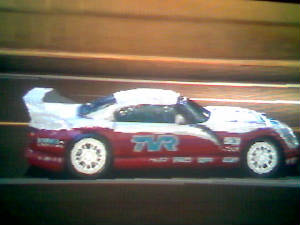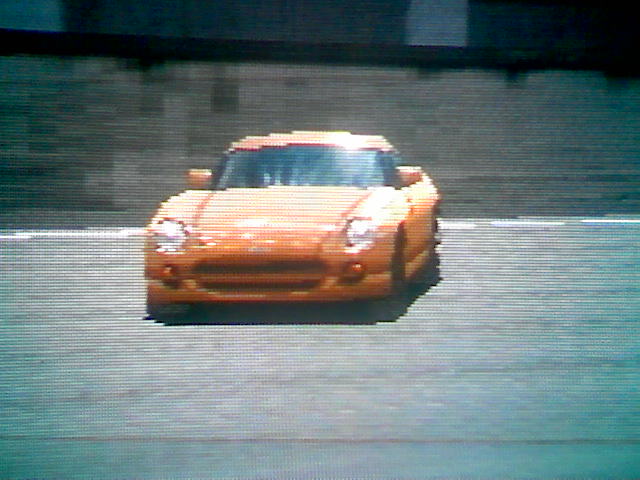|
SPEX
Year: 1996-2000 `````````````````````````````` Type: Sports Car
Country: England ``````````````````````````````` Host: GT1 & GT2
Price: $71,850 (Cerbera 4.2-GT2)
Length: 168.5" // Width: 73.4" // Height: 48.0"
Wheelbase: 101"
Overhang: @5' 7"
Track: 57.6" [F] 57.9" [R]
Ground
Clearance: 5.1"
Weight: 2,425 lbs.
Layout: front engine / rear drive
Suspension: double wishbone / coils / anti-sway
bars / shox
Brakes: vented discs
Tires: 225/45ZR-16 [F] 245/45ZR-16 [R]
Engine: 4.2 liter DOHC V8 (or OHV?)
Tested HP: 366 @ 6,500
rpm
Tsd Torque: 321 @ 4,500 rpm
Credits per HP: $196.31
Lbs. per HP: 6.63
HP per liter: 87.4
Aspiration: normal
Fuel System: EFi
valves per cyl: 2 or 4 according to various websites
Bore x Stroke: 3.46x3.39"
Compression:
10.0:1
Redline: 7,000 // RPM Limit: 8,000
Transmission: 5-speed manual
0-60 mph: 6.63 seconds
0-100mph: 11.371 seconds
400 M: 14.014 @ 113 mph
1 KM: 23.995 @ 149
mph
Test Track: 1:29.996
Top Speed
1st: 47 mph
2nd: 73 mph
3rd: 109 mph
4th: 146 mph
5th: 192.77 mph
-----------------EXTERIOR----------------------
The Cerbera follows in the Griffith's footsteps by placing form slightly ahead of functionality.
It has a sleekness to it, but looks more like something we'd see at a car show. It's definitely a good-looking car: wide,
low to the ground, and just as slipstreamed as the Griffith. It's a mixture of classic British (round headlamps included)
and concept car. In fact, the Cerbera is longer and has a longer wheelbase, which makes it heavier but also more balanced
and not as nose-heavy as the Griffith.
This car is more stable than a Griffith, but it's not perfect. The longer bodywork and 101" wheelbase does
make the Cerbera not as prone to spinning. It can be pushed harder, and is easier to correct when mistakes do occur.
Unfortunately, there are some flaws. Mainly the back-end of the car lacks downforce, yet the front end seems
to have plenty. We'll only notice this during some of the longer, faster turns (over 100 mph) when the car occasionally loses
traction. Again, the Cerbera's maneuverability is definitely better than the Griffith's, but this car is still challenging
to drive.
A nice feature is the lack of weight. You might hesitate to undergo full reductions if you want your Cerbera
to have more stability; if not, be prepared for occasional 2-wheel fun if you hit a curb here or there! Sometimes it seems
this car should be in a circus somewhere.
In GT1, there are two of these: the regular car we buy from the dealer and the LM. In GT2, there
are three: the 4.2, 4.5, and again the LM prize car.
---------------ENGINE / DRIVETRAIN-------------------
The engine in this car comes standard with loads of horsepower and plenty of mid-range
torque to wind those back wheels quickly. Only one stage of tuning is available in GT1, and for most racing situations, that's
all you'll need in this game. In GT2, the same is true: there are 3 na upgrades for the dealer-bought cars, but in my experience
(at the Pacific Regionals, anyways) i barely needed to modify my car to win.
In the 1st game, you won't even have to tune the engine if you get its weight off, unless you're planning
on racing in the hard-tuned or mega-speed events. The Cerbera is one of about 10 cars that will do well in the Stock car event,
though it will slide around the track like the Viper does, so bring your safety restraints.
A shortfall is that this engine lacks horses when compared with some others in any of the racing series.
Not only this, but its light weight means you'll be doing some driving with 2 or all 4 of the wheels off the pavement fairly
frequently at these high speeds. The lack of horsepower can be remedied if you happen to win the Japanese / British series
in GT1 or one of the enduros (i think) in GT2. You'll be rewarded with a brand-new Cerbera LM, which has about 100 more horses
than the car you buy at the shop, and can attain an incredibly low pound / power ratio.
One thing questionable about the engine (and this could be a fault of Gran Turismo's designers) is that
it doesn't sound much like a V8. I'm not sure what a real-life Cerbera engine sounds like (I've never even seen one!) but
to me this car sounds suspiciously like an inline 6. The Cerbera in the 2nd game sounds like my mom's Electrolux. The engine
BEHAVES like a V8, though, no doubt about that.
Lots of torque mid-range that peaks off just below the redline, lots of tire-screaming. You can get the
close or super-close gearbox, but don't use the super-close one on tracks like Grand Valley which feature a long straightaway
or the engine will clip. Like other high-performance vehicles, you won't need the racing gearbox unless you're absolutely
anal about setting your own ratios.
------------------CHASSIS / HANDLING--------------------
Here we have yet another well-balanced undercarriage for the most part. Standard or modified,
it has plenty of flexibility, though you may find that without sports, semi-racing, or racing tires, your car will be going
sideways on twisty tracks almost as much as it's going straight! Once you get over this (assuming you can master countersteer
and occasional drifting, that is) this car is as much fun to drive as a Viper, and has similar handling capabilities.
The tires are good but not sticky. Sports or semi-racing tires are good for intermediate races, while slicks
are fine for the GT cup and other advanced forays. All in all, there isn't much negative to say about this portion of the
car other than the fact that for some it will be annoying to drive (see the above sections for descriptions about 2-wheel
maneuvers). This is more a fault of the car's weight, not its suspension. Use low spring settings (with dampers set mid-range)
to help remedy this.
The brakes are excellent. You will not need the brake controller even when racing intermediate events, though
it does help a lot during advanced races. In GT2, the adjustable limited-slip device is a good buy to induce more understeer
or save yourself from some embarassing spins in races, but it's not the be-all and end-all for success. There is no substitute
for good driving, after all.

|
| TVR Cerbera LM edition (GT1) |
PROS
1). Light weight. You probably won't need to get reductions right away.
2). Lots of power, acceleration, and speed.
3). Brakes and suspension are balanced.
4). As is the car's bodywork.
5). Nimble handling characteristics. The LM or a dealer-bought car with a racing body installed will absolutely
tear the tracks up, even tho it's a rear-drive car.
CONS
1). Price. In GT1, it's near the top of the list.
2). Light weight creates some issues with stability.
3). Street tires don't have much lateral traction, making this car slippery to drive at times.
4). Did they really sample a V8 when they put this car in the game?
5). GT1 Cerbera only accepts one level of engine modification. Not that you'll often need to use it.
6). Oversteer. Learn to drift in a lesser car before attempting to drive ANY TVR!
Published: June 24, 2004
Click hERE FOR MORE REVIEWS
|



